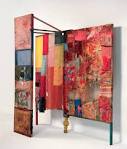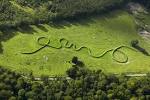
Minutiae are one of the earliest and biggest combines that have been created by Rauschenberg. It was created by Rauschenberg for his friends at the Brooklyn academy of arts in 1954. Their friendship is traced from the days they used to spend at the legendary Black Mountain College in the late 1940s (Diggory, 402). The main thing about Rauschenberg and his art is the fact that he lays out a picture with an ab-ex overlay.
In this artistic work, there is an effective repositioning of the aesthetic decision making process as it is in abstract expression. This is because it is basically used in literature as the element of security. Minutiae create a historic bridge between movements. Muntiae is a combination of oil paint, paper, fabric, newspaper, wood, and metal (Diggory, 431). In addition, it is also made of plastic with mirror as well as a string on a wooden structure on a beaded frame work.
Minutiae 1954 is extracted from its context but still holds to the fragments of the original meaning. Rauschenberg creates a collage using a multi media aimed at commenting on the saturated culture that media has brought to the community (Diggory, 403).
This is an implication that the Western culture has been gripped with a world of constant collage, a society that is focused on technology, as well as quotes and references This art work in addition presents an idea that the past never disappears from us. This is because it has been catalogued in the current virtual space digital memory. Furthermore, past interactions and communications have been catalogued and automatically saved for an imprecise time (Diggory, 415).
Rauschenberg combines panels, collaged photographic images, fabric found images together with some pieces of furniture unified with gestural images of brush work. As he calls it, “In the space between art and life”, Rauschenberg brings a move from the wall to the interactive environment. The main interest in this art work was to show the interest that for long lived in Rauschenberg. The interest in the physical environment was in him for early work. Again, the picture is an indication that painting relates to both life and art (Diggory, 451). This statement implies that life at all times will definitely reflect in any form of art work, moreover, as a strong affect on its materials.
Minutiae 1954 can be interpreted by the fact that two circumstances testify how powerful the aesthetic choices we make are. First, the over painting in the picture is an indication that the painting was modified. Secondly, is the fact that the picture presents the road that was never taken. In this case, it stands as a considerably connected entity in which a number of collage materials are gathered to work out with the purpose of serving the theme to be.
Unlike Rauschenberg later unites, “the two-dimensional collage materials lose their identity and history outside the picture plane” (Andrews 67). The end result is that they come to function more or less exclusively pictorially. In this case, Minutiae, is much more a traditional collage that is properly pioneered (Andrews 67). Again, the difference between these two models are shown outstandingly is the sense that collage can be reengineered to serve new pictorial purposes severed from their original purposes. The formal utility to the composition easily triumphs their object. However, “collage materials can also betray an extra-pictorial origin because their autonomous sign quality is rarely circumscribed by new pictorial context” (Langmead 166).

Maya Lin is an American artist and architect known for her splendid artistic work in sculpture and landscape art. Her best recalled art work is the Vietnam Veterans Memorial in Washington, D.C. Maya Lin has utilized the way scientist and computers see the universe. Lin’s drawings are in 3D (Langmead 166). Her drawings and images are based on the sonar view of the ocean floor to aerial and satellite views of the land (Langmead 166).
Maya’s art translates to technological view into the sculptural form. Drawings such as the 11 Minute Lines are generously illustrated and beautifully designed. The art work has a systematic landscape tracing her fascination with geological phenomena as well as phenomena. The drawing, at the same time, integrates natural contours and materials which evoke landscape sculptures (Langmead, 169).
Lin’s earth work and public sculpture have at the same time developed alongside small scale, exploratory sculptures together with monumental installations (Andrews 32). These include 11 Minute Line through which Lin manages to evoke the entire physical process that shapes the entire universe. Lin also creates a systematic landscape exhibition drawings and relief demonstrating the expanding scope of her creativity.
The art work takes a pixel like image, of a hill, as well as a close up in order to create a form evoking into peoples mind both mound together with wave, earth and water (Langmead 156). In addition, the systematic landscape of Lin’s piece of work is interesting to many newcomers in the art industry. This also applies to longtime enthusiast of her unique artistic work as well as stunning creativity.
Thematically, Lin tries to ensure that her artistic work relates to her architectural background. Owing to the fact that her reasons for involving in architecture were never theoretical, she begins her art work with a psychological understanding of the environment. The main interest here is the human response to the piece of work rather than architectural impression. Her work is different from westerner in the sense that the ideology behind it is not as that in the western culture which denies reference to culture. Her piece of art work originates from a form of simplicity that can as well be traced back to Shintoism, to Zen (Andrews 45). Having no background, knowledge on western philosophy or religion, Lin uses her art work to explain her problem with the way Western European culture was presented.
One of her themes in this art work is to present equity in all genders. She expresses her displeasure with the Western order where men were at the centre of everything. Men were at a position to order the entire world (Langmead 172). On the other hand, Lin brings the Eastern understanding of art and design with a different simplicity. This is an indication that everything can be handmade, and crafted including households.
In addition, this brings out a fundamental belief that non western art and culture deals with the notion of teaching. This in turn can be seen as passive in the Western perspective. 11 Minute Line is aimed at opposing facts and in turn let individuals interpret the ideas as per their understanding. In addition, the non western culture gives the viewer hope that his or her opinion in art work is trusted. As a result, everyone has the chance to have an individual view of the world focusing on certain information.
Furthermore, Maya Lin’s work is an initial gesture of landscape. In urban projects, this work creates responses to the hard, urban site while, at the same time, fighting to get back to the initial nature of land, admires and love for the earth artists.
Works Cited
Andrews, Richard. Maya Lin: Systematic Land scapes: [exhibitions, Seattle, Henry art, gallery, University of Washington, 2006. New Haven: Yale University Press, 2006.
Diggory, Terence. Encyclopedia of New York School Poets. New York: Facts on File, 2008.
Langmead, Donald. Maya Lin: a Biography. Santa Barbara: Greenwood. 2011.